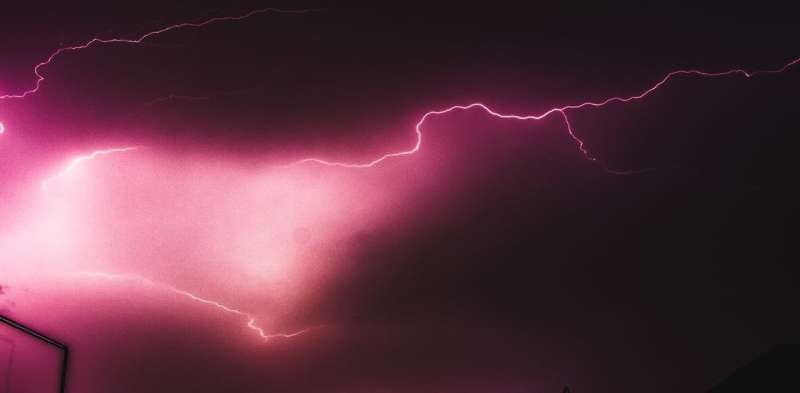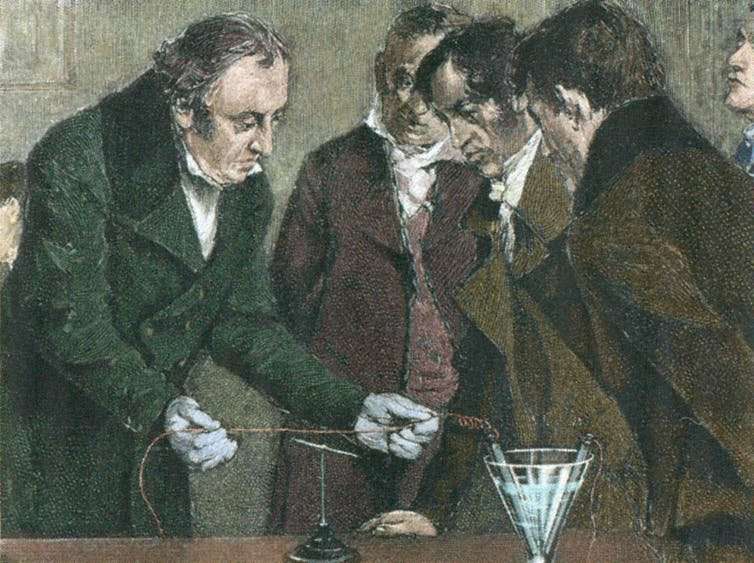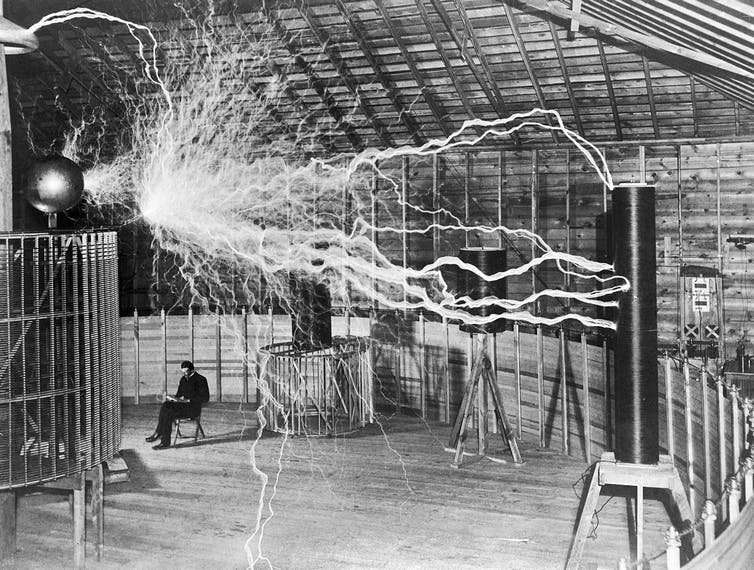How electromagnetism haunts our everyday life

Electromagnetism has haunted the human imagination for thousands of years. From the ghostly Northern Lights of ancient aurora mythology to the evil electromagnetic forces in the popular TV show Twin Peaks, electromagnetic energy continues to endure as a source of spooky speculation. Its mystical fields and mysterious frequencies have inspired spiritualists, New Agers, paranormal investigators and conspiracy theorists alike.
Electromagnetism was first discovered in the 19th century, when scientists recognised that the interaction of electrical currents and magnets could make objects move without touching. This suggested that the apparently distinct forces of electricity and magnetism were actually intimately related. Hans Christian Ørsted, Michael Faraday and James Clerk Maxwell proposed that invisible electromagnetic "fields" and "waves" were behind this spooky action at a distance. Their experiments marked the beginning of the Electromagnetic Age and paved the way for a radical new understanding of the dynamics of the universe.
Victorians suddenly found themselves living in a world newly conceived as awash with unseen electromagnetic entities. And these dynamic forces, fields and fluxes provided a logic and a language for occult occurrences.
Physical to psychical
New technologies were developed to visualise, access and unlock the mysteries of this previously unseen and inaccessible energy-world. The telegraph and, later, the radio, tapped into unseen regions of electromagnetic radiation. These technologies allowed for a form of disembodied communication that opened up imaginative possibilities for contacting the dead. Media historian Jeffrey Sconce has explored the role of the electromagnetic imagination in the spiritualist movement, for whom the mysterious force offered a vital link between physical and psychical realms.

Electromagnetism continued to figure prominently in 20th-century explorations of the supernatural. UFO, poltergeist and other paranormal encounters were often accompanied by a disturbance of the local electromagnetic environment – white noise on radios, static on television sets, car engines switching off or domestic appliances acting strangely (tropes that persistently feature in horror and sci-fi TV shows from The X-Files to Stranger Things). Electromagnetic wavelength filters and field meters were deployed to register these energetic presences. For some, however, the real spooks were not the ghosts or aliens but the electromagnetic fields themselves, generated by the transmission towers of the military-industrial complex.
Electromagnetism proved a wellspring for conspiracy theories related to energy weapons, mind control and weather warfare. Early experiments with wireless transmissions had led to many inventors, including Nikola Tesla, Guglielmo Marconi and Harry Grindell Matthews, claiming they had built a "death-ray" that could direct a powerful blast of electromagnetic energy. The mysterious Tunguska Event of 1908 in Siberia – the largest impact event on Earth in recorded history – may be linked to Tesla's electromagnetic energy beam experiments.
The Soviet Union's Duga Radar System (that released the famous Russian Woodpecker signal around the world) and the US government's High Frequency Active Auroral Research Programme (HAARP) instigated "tin-foil hat" fears of radio frequency brainwashing. There is speculation that the recent "health attacks" on American diplomats at the US embassy in Cuba were carried out with some sort of directed electromagnetic energy weapon.

Everyday electromagnetism
Often dismissed as pseudoscientific paranoia, these fringe theories nevertheless expressed a growing concern about the health risks of living within an increasingly electromagnetic environment. Alongside the natural electromagnetic activity of lightning storms, auroras and space weather, an accelerating array of man-made electromagnetic fields were being generated by modern electrical appliances and the power grids, radio antennae and mobile phone masts of the industrial landscape.
Cultural anxieties surrounding this electromagnetic "pollution" were succinctly articulated by Don DeLillo in his 1985 novel White Noise:
"The real issue is the kind of radiation that surrounds us every day. Your radio, your TV, your microwave oven, your power lines… Forget spills, fallouts, leakages. It's the things right around you in your own house that'll get you sooner or later. It's the electrical and magnetic fields."

More recently, in Mark Frost and David Lynch's 2017 revival of Twin Peaks, the ambient electromagnetism that forms the background of our technology-driven daily lives becomes an omnipotent sinister force. The mundane landscape of electromagnetic infrastructure – the pylons, telegraph poles and plug sockets we've trained ourselves not to see – take on supernatural significance as portal-generators to extradimensional negative spaces.
Lynch's films often work to reveal the horrifying forces beneath the mundane surface of everyday life – take a look at the palpitating insects swarming amid the manicured suburban lawns of Blue Velvet:
For Lynch, it seems, the really scary thing about electromagnetism is how such a mysterious force can appear so utterly mundane – the way this strange energy is permanently present yet never noticed; the way the monolithic infrastructure goes by completely unseen; the way we seem too anaesthetised and technology-dependent for the possibility of fear or fascination to even arise. Here, the truly disturbing thing about electromagnetism is not that it reveals a weird new world, but that it reveals how blind we are to the everyday weirdness of the world.
Today, in our world of ubiquitous WiFi, smartphones, data streams and contactless emanations, it is the data ghosts of our digital lives that we increasingly imagine to haunt the electromagnetic realm.
Mysterious yet mundane, palpable yet immaterial and existing at the edges of perceptible experience, the energies, forces and fluxes of electromagnetism continue to power and perturb everyday life.
Provided by The Conversation
This article was originally published on The Conversation. Read the original article.![]()




















